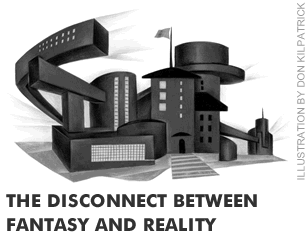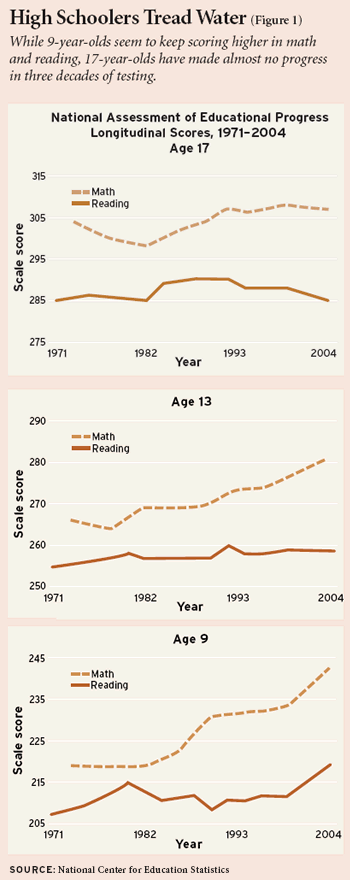 To say that improving high-school student achievement is like turning a supertanker around would be an insult to the speed and maneuverability of supertankers. Whether one looks at standardized test scores, at graduation rates, or at college admission test results, American high-school performance has hardly budged over the past three decades.
To say that improving high-school student achievement is like turning a supertanker around would be an insult to the speed and maneuverability of supertankers. Whether one looks at standardized test scores, at graduation rates, or at college admission test results, American high-school performance has hardly budged over the past three decades.
This stagnation is not for lack of trying. We have poured more money into schools, hired an army of new teachers to reduce class size, expanded professional development, and retained more experienced teachers—everything that the teacher unions have in mind when they repeat their mantra that we know what works and just need the resources to do it. We have doubled per-pupil spending (after adjusting for inflation) over the past three decades. We reduced the student-teacher ratio in high schools from 21.7 students per teacher in 1960 to 19.8 in 1970, and, by 1999, to 14.1. The percentage of teachers holding master’s or doctoral degrees has more than doubled, from 27.5 percent in 1971 to 56.8 percent in 2001. The average teacher in 2001 had 14 years of experience compared with 8 years of experience in 1971.
 But none of it has worked.
But none of it has worked.
According to the National Assessment of Educational Progress (NAEP), the average 17-year-old today is no more proficient at reading or mathematics than his counterpart in 1970 (see Figure 1). Some progress has been made by our 9- and 13-year-olds, but the gains evaporate by the time these students reach the end of their K–12 experience. The average 17-year-old student’s score on the NAEP reading test was 285 in 2004, exactly the same as in 1971. Math results are no different, going from a score of 304 in 1973 to 307 in 2004, a change that is not statistically significant.
This lack of advancement is more disappointing considering how low the achievement bar has been. Only about one in four of the high-school graduates who took the American College Testing (ACT) program’s college-readiness test last year met the benchmarks in reading comprehension, English, math, and science. The organization, founded in 1959, called it a “College Readiness Crisis” last year; this year the scores were “unchanged.… Students graduate from high school ready or not.” And according to the standards established by NAEP, they’re not: 64 percent of 12th graders performed below the proficient level on NAEP’s most recent reading test; more than a quarter read at less than what NAEP deemed a “basic” level. On the most recent administration of the NAEP math test, a striking 83 percent of 12th graders scored below the proficient level, and 35 percent scored below the basic level. On the most recent NAEP science test, 82 percent of 12th graders performed below the proficient level, and 47 percent scored below the basic level.
The gloomy picture painted by the ACT and NAEP is confirmed by high-school graduation statistics and college entrance test results. According to the U.S. Department of Education’s Digest of Education Statistics, just 72 percent of students graduated from high school with a regular diploma in 2002, compared with some 77 percent in 1970. More alarming is the fact that almost half of the students who do graduate are essentially ineligible to go on to a four-year college because they have not taken the minimal coursework needed to apply to virtually any four-year institution. While SAT scores are not particularly useful for long-term analyses of high-school performance because they include only a limited and changing pool of students, they do tell us something about the elite group that does pursue higher education. Even among this population achievement has not been improving. SAT scores in reading dropped from 537 in 1970 to 507 in 2003. Math SAT scores have inched up from 512 in 1970 to 519 in 2003. The lack of improvement among the college-bound elite is more evidence that the stagnation in high-school achievement is not concentrated among the most disadvantaged students.
The problems with our high schools are chronic, widespread, and painfully obvious.
Doing What Doesn’t Work
What is not so obvious is what to do to fix the problems. We have significantly increased per-pupil spending, hired an army of additional teachers, and greatly increased the formal training those teachers have received. In short, we have focused considerable energy on increasing the resources available for education. But we have not improved the motivation of administrators and educators to use those resources effectively. Attending to resources without attending to motivation is like filling a race car with fuel and then putting an infant behind the wheel. You just won’t go anywhere.
The problem isn’t lack of resources. The problem is that we don’t think about high schools correctly. We lump them with elementary schools, part of the K–12 system, rather than with colleges, with which they have much more in common. By so organizing and conceptualizing high schools, we underemphasize the need to provide secondary-school educators with incentives that are more like the incentives of their closer relative, college. The high schools that we created in the 20th century—big, sprawling, “comprehensive”—are not like elementary and preschools. They are not natural extensions of families, and their teachers and administrators should not be expected to act as if they were members of a family.
If parents fall short in raising their children, we generally assume, it has more to do with resources, time, knowledge, or experience than with motivation. We similarly assume that teachers aren’t motivated by external rewards or punishments, but by their love of the students. Such thinking is why elementary- and secondary-school reform focuses almost exclusively on resources (per pupil spending), time (class size), knowledge (professional development), or experience (teacher retention) and relatively little on incentives to make educators perform better.
Even if elementary schools can be run effectively like big families, it is unlikely that most high schools, with more than 1,000 students, could be. They are just too big, the kids are not cuddly enough, and the skills that have to be conveyed to students are too complicated. Unless they are made dramatically smaller, high schools have to be run more like professional organizations or businesses and less like families.
The Gates Foundation Strategies
This logic is why the new wave of high school reform efforts, led by the Bill & Melinda Gates Foundation (see “A Foundation Goes to School”), has focused on the disconnect between the reality of big, modern high schools and our fantasy of them as extensions of the family. Gates has addressed this disconnect with various strategies. For example, they have pushed to reduce the size of public high schools, in the belief that small high schools, like families, can succeed by developing a strong, shared sense of mission among faculty and students. In small high schools, the theory goes, the motivation of educators, like the motivation of parents, is buttressed by strong informal bonds between everyone. Whether this theory is producing results is unclear at this point as we do not yet have a large amount of rigorous evidence on the effects of reducing high-school size. But the strategy clearly is to make high schools as small as many elementary schools so that they will acquire more family-like qualities.
Another strategy, also promoted by the Gates Foundation, is to make high schools more like colleges. These “early-college” high schools do not coddle their students like elementary schools do. They have open campuses, they offer a broad set of electives, and they employ college faculty. For the most part, the Gates early-college initiative focuses on the motivation of students, hoping that greater autonomy and more challenging material will help keep them engaged and interested in school.
But the early-college idea also highlights the importance of altering the motivation of staff. Colleges devise explicit systems of rewards and sanctions to enhance motivation. Unlike public high schools, colleges do not pay faculty solely on the basis of years of experience and degrees held. Colleges generally attempt to measure the merit of faculty by tracking grant dollars generated, counting the number of publications produced, and administering teacher evaluations, among other criteria. Pay is determined, at least in part, by these performance evaluations. Faculty compensation in college, unlike public high school, is also influenced by market demand for those faculty members, so people in some fields are paid significantly more than others and outside offers are sometimes matched. While colleges, like high schools, offer their faculty members tenure, their evaluation of faculty productivity tends to be much more rigorous.
To be sure, colleges fall far short of optimal efficiency and operate in a regulated and subsidized environment that provides them with financial incentives to neglect students in favor of research. But the somewhat better attention to merit incentives in colleges has helped make our higher education system the envy of the world, while our K–12 public schools, almost entirely lacking external incentives, are not.
Focusing on Motivation
Families are not impervious to incentives, but those incentives are shaped by informal bonds more than by explicit systems of rewards and sanctions. Even modern organizations, such as businesses or universities, evoke familial incentives as part of their efforts to motivate staff, using terms like “our corporate family,” sending out employee newsletters that read like family holiday letters, and going on “retreats” as if they were family vacations. Of course, businesses do not rely solely, or even mainly, on familial incentives; K–12 schools do.
Unfortunately, public high schools have barely begun to tap nonfamilial incentives to motivate their staff. Many high schools have begun to administer high-stakes tests, which collect some information on outcomes and offer some rewards and sanctions for productivity. But the measures of outcomes are limited, the rewards and sanctions are weak, and individual employees are largely unaffected by these incentives. Assigning a failing grade to a school as a result of high-stakes testing may be politically embarrassing, but it usually has no effect on school budgets and almost never has any meaningful consequences for individual teachers.
The lack of choice and competition among high schools is at the heart of the problem. In particular, if high schools have to compete for their students and revenues because of vouchers or charter schools, they will figure out how best to motivate their staff to improve quality and attract students. Some high schools will adopt their own high-stakes testing systems to measure and reward productivity. Other high schools may decide that they can motivate their staff best by reducing size and by increasing the familial incentives of their organization. The variety of arrangements to motivate staff to successfully compete is impossible to fully anticipate or describe.
The point is that the market incentives that vouchers and charter schools can bring to high schools will focus school leadership on the problem of motivation. Those leaders will no longer be able to maintain the fantasy of high-school educators floating from classroom to classroom like Mary Poppins because of their love of children while at the same time haggling over pay, benefits, and working conditions as if they were automobile workers. Either high schools will really have to embrace family incentives by becoming significantly smaller and more informal, or they will have to admit that they are large, modern organizations that require explicit systems of rewards and sanctions to enhance productivity. Either way, they need competition to force them to address the issues of motivation and improvement.
Jay P. Greene is professor of education reform, University of Arkansas, and a senior fellow at the Manhattan Institute. He is author, most recently, of Education Myths: What Special-Interest Groups Want You to Believe about Our Schools—And Why It Isn’t So.


